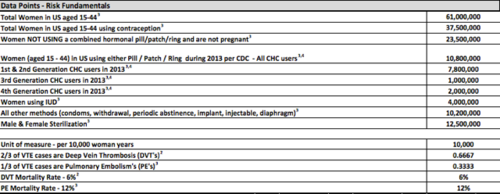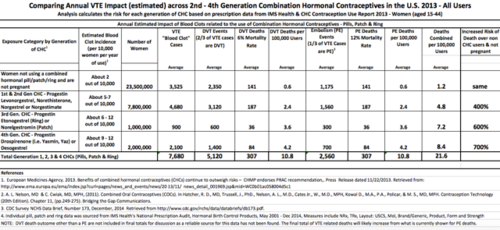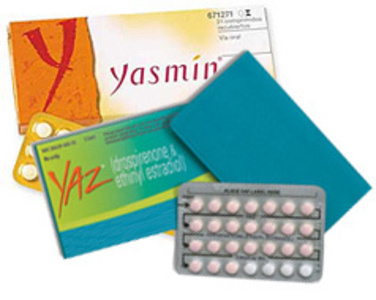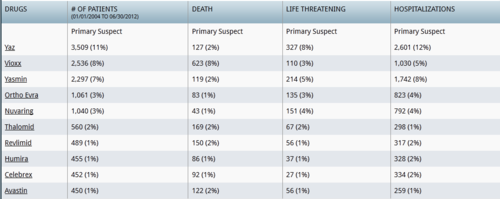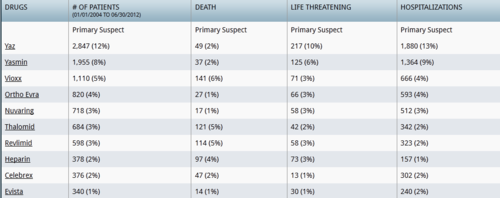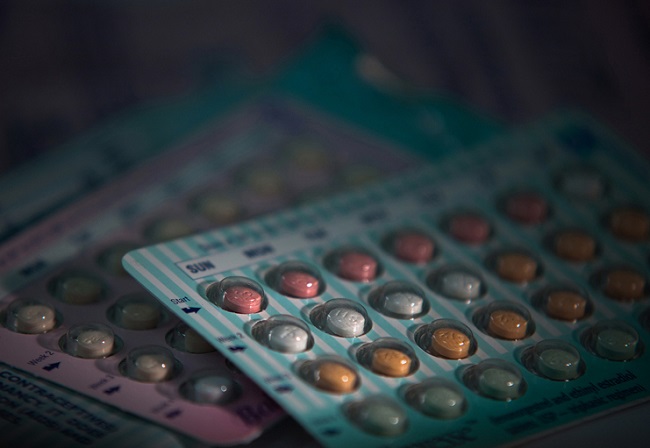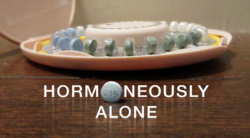A few weeks ago, someone posted a news article on Facebook about another young woman who almost died from her hormonal birth control. One Facebook commenter made a remark that she hated the fear mongering that goes on about hormonal birth control in the news. I, on the other hand, truthfully wish more women knew what to fear. My 29-year-old daughter Julia died in 2013 from massive bi-lateral pulmonary embolisms while using NuvaRing as her birth control. We had just celebrated her marriage to a wonderful young man. Julia had been married exactly five weeks on the day she died. I cannot even begin to describe the grief we feel about her death to this day.
That Facebook comment made me think about what I now see as the fear mongering that the medical community engages in when they insist that the risk of blood clots during pregnancy and postpartum (after delivery) must always be mentioned to put the risk of blood clots “in perspective.” I began to wonder if we really know enough about the risks of blood clots with hormonal contraceptives.
Beyond Fearmongering: Learning from the Families who Lost Loved Ones to Hormonal Contraceptives
My daughter’s death led me to meet Joe Malone whose 23-year-old daughter Brittany died in 2012, also while using NuvaRing. Our daughters’ deaths have taken us on a long and frustrating journey to learn more about combination hormonal contraception (CHCs) and why our daughters died.
Joe and I understand why the medical community wants to make sure that women use some form of birth control. Maternal mortality is very high, especially in third-world countries. There are many health complications and dangers for women during pregnancy and in the weeks after delivery from a variety of causes. The risk of a blood clot is high. However, we now see how the information given about the risks for blood clots during pregnancy and postpartum is presented in such a way that seems intent on scaring women into taking hormonal contraceptives. There is little discussion about safety between the various types of hormonal birth control (pill, patch, ring, IUD or shot), or other options, such as a copper IUD or other non-hormonal methods. Every hormonal contraceptive and every formulation is pronounced safe and the risk of a serious event is declared rare.
Women are told to talk with their healthcare provider about these risks to learn more. We have found that this suggestion is insufficient because many of these providers themselves, do not understand the different risks associated with each contraceptive formulation/brand.
Inevitably, accompanying any mention of risk from a hormonal contraceptive is the stark warning that the danger of a venous thromboembolism (VTE) – a blood clot in leg or lung) is higher while pregnant or postpartum. We have learned the hard way that the risk of a blood clot may be higher, but the possibility of death from a PE while using combined hormonal contraception is even greater.
Risk for Blood Clots with Hormonal Contraceptives versus Pregnancy or Postpartum
After careful review of data from various governmental and independent agencies (see below for discussion), we now believe that the overemphasis on the risk of VTE in pregnancy creates a false sense of security regarding the safety of combined hormonal contraceptives compared to pregnancy. It minimizes the reality that something very dangerous can happen to a small, but recognizable, percentage of women who use hormonal contraceptives. Women are led to believe that hormonal contraceptives are much safer than being pregnant due to the VTE risk in pregnancy. Women are not instructed on how to recognize the early warning signs of a dangerous and potentially deadly blood clot, and sadly, we also discovered that neither are their doctors. According to data from the CDC,
more U.S. women died from pulmonary embolisms while using a combination hormonal birth control than from pulmonary embolisms while pregnant or postpartum in 2011.
There were approximately 69 deaths in the U.S. from pulmonary embolisms during pregnancy and post-partum in 2011 (the latest date for which these numbers are available), compared with approximately 307 deaths due to pulmonary embolisms for women who used a combined hormonal contraceptive pill, patch or ring in 2013 in a recent analysis Joe and I completed. A full analysis is posted on BirthControlSafety.org.
We believe the reason there are fewer deaths from a pulmonary embolism during pregnancy is that most women who are pregnant or have recently given birth are monitored much more carefully than women who use hormonal contraceptives. A woman who utilizes birth control pills, patches or a ring is seen only annually by her physician and very rarely advised of the signs and symptoms of blood clots.
When signs of potential blood clots emerge, such as chest pain, difficulty breathing or leg pain, women are told that they have bronchitis, pneumonia, asthma or a pulled muscle. You can read first-hand accounts from both men and women on a site called stoptheclot.org. When you read these stories, you hear how the medical community has a very difficult time diagnosing deep vein thrombosis or pulmonary emboli. People who go to their doctor with the symptoms of a blood clot in their lungs or leg, are more likely than not, told to take an antibiotic, a pain reliever or muscle relaxant and come back later. For many, later is often too late.
Women Who Die from Contraceptive Induced Blood Clots
Our review of the data suggest more U.S. women die from VTEs while using a combined hormonal contraceptive than during pregnancy or postpartum. This is in contrast to what is commonly reported.
Tragically, a significant number of women do die during pregnancy and the postpartum period, but they die from a variety of reasons that have nothing to do with a pulmonary embolism. You can read the list of other reasons that women die while pregnant or postpartum in the list from the CDC website. Some of the reasons for these deaths are preeclampsia, hemorrhage, and complications of caesarean section: many conditions that only occur during pregnancy or postpartum.
A 2015 study by Vinogradova, Coupland, and Hippisley-Cox published in the British Medical Journal on the use of combined oral contraceptives and risk of venous thromboembolism [8] put the risk at an even higher rate than the rates we used from the European Medicines Agency (EMA). So it is likely that we underestimated death rates associated with contraceptive induced blood clots.
Next time you read the disclaimer that “Pregnancy and the postpartum period puts a woman at higher risk for a VTE” maybe you’ll remember that this claim may not be entirely true. From what we can tell, more women die of a pulmonary embolism while using combination hormonal birth control than while pregnant or in the postpartum. Hopefully, women will become better educated to take care of their health issues before, during, and after pregnancy. In the meantime we need to educate every woman about what combined hormonal contraceptives do to a woman’s body.
Calculating the Risk for Death by Venous Thromboembolism
The CDC monitors Maternal Mortality and publishes figures on their website. For all deaths reported in 2011, “702 were found to be pregnancy-related.” This total includes deaths that occurred for a full year after childbirth [1] they also report that 9.8% of maternal deaths during pregnancy and postpartum are attributed to thrombotic pulmonary embolism. We calculated that a 9.8% rate equaled 69 deaths in 2011. At present, there are no published mortality figures from the CDC for 2013.
It is difficult to find the number of women who die from a blood clot in their lungs while using a hormonal contraceptive. The FDA’s Adverse Event database is voluntary, inconsistent and difficult to interpret. Some columns, such as the Outcome column are left blank. Even the FDA has acknowledged in the past that only 10 to 15% of adverse events are reported [2]. The FDA requires that pharmaceutical companies report adverse events, but no one else is required to report to the FDA or even to the pharmaceutical companies. Many healthcare professionals do not bother to report to the FDA, and it is unknown if they report anything to the pharmaceutical companies.
To try to understand the number of deaths caused by blood clots in the lungs, we relied on the VTE rates that the European Medicines Agency (EMA) publishes. In 2014, the EMA circulated a table of VTE rates [3]. This table gives a range for each type of progestin hormone involved in each of the combined hormonal contraceptives.
In the U.S., the FDA allows companies to put a chart on the package inserts listing estimates of venous thromboembolism which are currently estimated at 3-12 events per 10,000 women, but that number is lumped together for all formulations of hormonal contraceptives. By combining the rate of blood clot for each of the different types of hormonal contraceptive, it is impossible to look more deeply at the figures, especially at which hormones might be causing more blood clots. The EMA information allows this type of review.
We also purchased the prescription data from IMS Health and used information from the CDC to determine the number of women in 2013 that used different combination hormonal birth control products. IMS Health is a leading global information and technology services company, providing prescription drug data to a variety of corporations, and groups, including the FDA. The EMA gives a range of VTE rates based on the type of progestin hormone used, illustrated in Table 1.
Table 1: EMA Risk of Developing a Blood Clot.
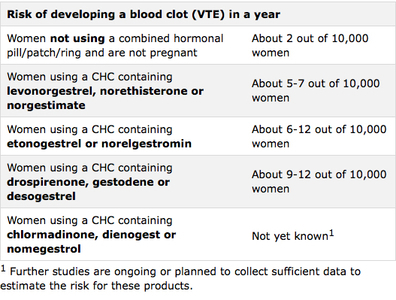 Because the number of deaths while using a combined hormonal contraceptive is unknown, we decided to calculate how many women might die. We used information from the reference book Contraception Technology [3], which says that 66% of women with a VTE will have a deep vein thrombosis and 33% with a VTE will have a pulmonary embolism. They cited a death rate of 6% for women with a DVT, and a death rate of 12% for women with a pulmonary embolism.
Because the number of deaths while using a combined hormonal contraceptive is unknown, we decided to calculate how many women might die. We used information from the reference book Contraception Technology [3], which says that 66% of women with a VTE will have a deep vein thrombosis and 33% with a VTE will have a pulmonary embolism. They cited a death rate of 6% for women with a DVT, and a death rate of 12% for women with a pulmonary embolism.
Using the data for contraceptive methods published in 2013, which is very similar to the CDC’s 2011 data, we calculated that there were approximately 11,000,000 women using a hormonal contraceptive that contained an estrogen and a progestin. The basic information is shown in Table 2.
Table 2: Comparing VTE Impact (estimated) across 2nd – 4th Generation Combination Hormonal Contraceptives for U.S. Women in 2013.
Next we calculated the estimated number of women potentially affected with a VTE, DVT, or PE using both the low and high EMA rates. We then calculated an average of these numbers. The estimated average number of deaths in 2013 from a pulmonary embolism is 307 deaths. This does not include deaths from a deep vein thrombosis, stroke, cerebrovascular accident, or hemorrhage or any other cause triggered by a combined hormonal contraceptive. Table 1 looks at the estimated rate of VTEs for different generations of contraceptives while Table 3, shows our calculations for VTEs, DVTs or PEs events [5].
Table 3: Calculations for VTEs based on type of progestin.
Joe Malone recently calculated the number of deaths in another way. He took the number of U.S. births in 2013, published by the National Center for Health Statistics[6], and numbers from a study by A.H. James [7] who stated that “VTE accounts for 1.1 deaths per 100,000 deliveries, or 10% of all maternal deaths.”
Using information from James’ study, Joe calculated that approximately 43 women died because of a VTE in 2013. (See Table 4). This number is far lower than the 307 women we calculated to have died in our analysis of women on combined hormonal contraceptives. The lower number of deaths in James’ study may be due to several factors. For example, James’ study was of deliveries, not pregnancies. The number of deliveries likely is lower than the number of women who become pregnant. Another factor might be that the number of deaths reported on the CDC website of pregnant women includes women who died up to one full year after giving birth, which would result in higher totals.
Table 4: Comparison of VTE Related Deaths – Pregnancy & CHC Use
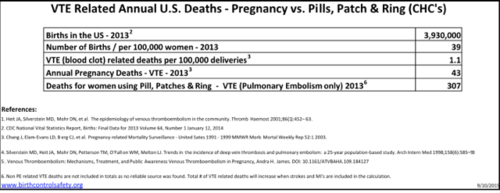 By whatever numbers we used, however, the death rate attributed to blood clots was higher in women using hormonal contraceptives than in pregnancy or postpartum. Moreover, the death rate was significantly higher. By continuing to suggest that the risk for blood clots, and indeed, death as a result of those blood clots, is higher in pregnant and postpartum women than in women using hormonal contraceptives, we place the health and well-being of millions of women in danger; and for some, this risk is deadly.
By whatever numbers we used, however, the death rate attributed to blood clots was higher in women using hormonal contraceptives than in pregnancy or postpartum. Moreover, the death rate was significantly higher. By continuing to suggest that the risk for blood clots, and indeed, death as a result of those blood clots, is higher in pregnant and postpartum women than in women using hormonal contraceptives, we place the health and well-being of millions of women in danger; and for some, this risk is deadly.
When I think about the fear mongering comment made in regards to an article about hormonal contraceptive safety, I cannot help but wonder if more information were made available, fewer families would experience the loss of a daughter, wife or mother. Understanding the real risks associated with a medication shouldn’t be considered fearmongering, just the opposite. In fact, to elevate the risk of death due to blood clots in pregnancy or postpartum above those of the medication, is not only fear mongering but dangerous.
Real Risk Study: Birth Control and Blood Clots
Lucine Health Sciences and Hormones Matter are conducting research to investigate the relationship between hormonal birth control and blood clots. If you or a loved one have suffered from a blood clot while using hormonal birth control, please consider participating. We are also looking for participants who have been using hormonal birth control for at least one year and have NOT had a blood clot, as well as women who have NEVER used hormonal birth control. For more information or to participate, click here.
References and Resources
- Pregnancy Mortality Surveillance System, Centers for Disease Control and Prevention, Division of Reproductive Health, National Center for Chronic Disease Prevention and Health Promotion. Updated December 23, 2014. http://www.cdc.gov/reproductivehealth/MaternalInfantHealth/PMSS.html/.
- Hazell, L. & Shakir, S. A. W. Under-Reporting of Adverse Drug Reactions A Systematic Review. Drug Safety 2006; 29 (5): (pp. 385-396). Retrieved from https://www.eecs.berkeley.edu/~daw/teaching/c79- s13/readings/AdverseDrugReactions.pdf
- European Medicines Agency. (2013). Benefits of combined hormonal contraceptives (CHCs) continue to outweigh risks – CHMP endorses PRAC recommendation,. Press Release dated 11/22/2013. Retrieved from: http://www.ema.europa.eu/ema/index.jsp?curl=pages/news_and_events/news/20 13/11/ news_detail_001969.jsp&mid=WC0b01ac058004d5c1
- A. L. Nelson, M.D. & C. Cwiak, M.D., MPH, (2011). Combined Oral Contraceptives (COCs). In Hatcher, R. D., MD, Trussell, J., PhD., Nelson, A. L., M.D., Cates Jr., W., M.D., MPH, Kowal D., M.A., P.A., Policar, & M. S., MD, MPH. Contraception Technology (20th Edition). Chapter 11, (pp.249-275). Bridging the Gap Communications.
- Malone, J., West, D. & West, J. (2015) Retrieved from www.birthcontrolsafety.org, http://www.birthcontrolsafety.org/data–references.html and www.Nuvaringtruth.com, http://nuvaringtruth.com/women-injured-or-died-from-combination-hormonal-birth-control-in-2013/
- NCH Data Briefs, Number 175, December 2014. Births in the United States, 2013. Retrieved from http://www.cdc.gov/nchs/data/databriefs/db175.pdf
- James, A. H. (2009). Venous thromboembolism in pregnancy. Arteriosclerosis, thrombosis,and vascular biology, 29(3), 326-331. Retrieved from http://atvb.ahajournals.org/content/29/3/326.full
- Vinogradova Yana, Coupland Carol, Hippisley-Cox Julia. Use of combined oral contraceptives and risk of venous thromboembolism: nested case-control studies using the QResearch and CPRD databases BMJ 2015; 350: h2135. Retrieved from http://www.bmj.com/content/350/bmj.h2135

